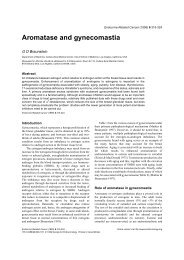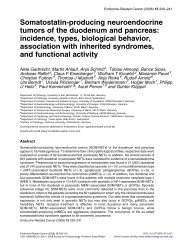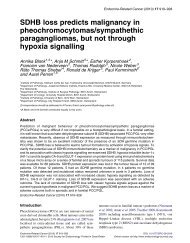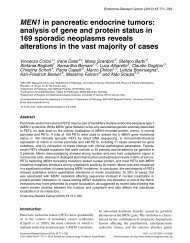Management of risk of breast carcinoma in postmenopausal women
Management of risk of breast carcinoma in postmenopausal women
Management of risk of breast carcinoma in postmenopausal women
You also want an ePaper? Increase the reach of your titles
YUMPU automatically turns print PDFs into web optimized ePapers that Google loves.
Biglia et al.: Breast <strong>carc<strong>in</strong>oma</strong> <strong>in</strong> <strong>postmenopausal</strong> <strong>women</strong><br />
Figure 4 Cumulative <strong>in</strong>cidence <strong>of</strong> all <strong>breast</strong> cancers <strong>in</strong> placebo and raloxifene-treated groups (modified from Cumm<strong>in</strong>gs et al.<br />
1999).<br />
the <strong>risk</strong> <strong>of</strong> <strong>breast</strong> cancer did not change <strong>in</strong> the group <strong>of</strong><br />
<strong>women</strong> with low endogenous estrogen levels. This f<strong>in</strong>d<strong>in</strong>g<br />
led the authors to suggest that high estrogen concentrations<br />
are likely to stimulate <strong>breast</strong> cancer so that a greater<br />
impact <strong>of</strong> raloxifene is expected as compared with patients<br />
with low levels <strong>of</strong> endogenous estrogens.<br />
Raloxifene is usually well tolerated and side-effects<br />
are limited to a higher frequency <strong>of</strong> hot flushes, cramps <strong>of</strong><br />
the lower limbs and fluid retention. The most significant<br />
problem is the <strong>in</strong>creased <strong>in</strong>cidence <strong>of</strong> deep venous<br />
thrombosis and pulmonary embolism, similar to that<br />
observed with HRT and tamoxifen. Raloxifene has also<br />
elicited new cases <strong>of</strong>, or worsened, diabetes mellitus but it<br />
does not appear to <strong>in</strong>crease the <strong>risk</strong> <strong>of</strong> endometrial<br />
<strong>carc<strong>in</strong>oma</strong> (Cumm<strong>in</strong>gs et al. 2002). In a further analysis <strong>of</strong><br />
the MORE trial data, the number <strong>of</strong> cardiovascular<br />
events (def<strong>in</strong>ed as all coronary and cerebrovascular<br />
events) did not <strong>in</strong>crease after 1 year <strong>of</strong> raloxifene<br />
treatment. After 4 years, raloxifene also proved to be<br />
effective <strong>in</strong> reduc<strong>in</strong>g the <strong>risk</strong> <strong>of</strong> cardiovascular disease, at<br />
least <strong>in</strong> a series <strong>of</strong> 1035 high-<strong>risk</strong> patients (RR = 0.60,<br />
95% CI = 0.38–0.95) (Barrett-Connor et al. 2002).<br />
Based on these promis<strong>in</strong>g data, a new trial <strong>of</strong><br />
chemoprevention compar<strong>in</strong>g tamoxifen and raloxifene <strong>in</strong><br />
high-<strong>risk</strong> <strong>women</strong> has been designed (STAR trial). This<br />
trial will allow a comparison <strong>of</strong> the benefits <strong>of</strong> these two<br />
drugs. An <strong>in</strong>direct comparison rely<strong>in</strong>g on the data<br />
obta<strong>in</strong>ed <strong>in</strong> the BCPT and MORE trials cannot be<br />
made as the populations <strong>in</strong> the two studies are completely<br />
different. In the American study <strong>women</strong> with a high <strong>risk</strong><br />
<strong>of</strong> <strong>breast</strong> cancer were <strong>in</strong>cluded and the power <strong>of</strong> the study<br />
derives from the large number <strong>of</strong> events (264 <strong>in</strong>vasive<br />
tumors and 104 DCIS). In contrast, the MORE trial was<br />
carried out on <strong>women</strong> with osteoporosis and thus at lower<br />
<strong>risk</strong> <strong>of</strong> <strong>breast</strong> cancer. In the STAR trial, 22 000<br />
<strong>postmenopausal</strong> <strong>women</strong> at high <strong>risk</strong> <strong>of</strong> <strong>breast</strong> cancer<br />
will be compared, but data will not be available for 7<br />
years. As a consequence, despite the favourable data <strong>of</strong><br />
the MORE trial, raloxifene cannot be currently prescribed<br />
as a chemopreventive drug for <strong>breast</strong> cancer.<br />
Modification <strong>in</strong> lifestyle<br />
The association between changes <strong>in</strong> lifestyle and modification<br />
<strong>of</strong> <strong>breast</strong> cancer <strong>risk</strong> has yet to be confirmed.<br />
High alcohol <strong>in</strong>take (more than three glasses a day) is the<br />
only dietary component significantly related to the <strong>risk</strong> <strong>of</strong><br />
<strong>breast</strong> cancer. Other components, <strong>in</strong>clud<strong>in</strong>g fat <strong>in</strong>take, do<br />
not show any significant correlation with the <strong>risk</strong> <strong>of</strong> the<br />
disease. Similarly, there are no cl<strong>in</strong>ical data to assert that<br />
an <strong>in</strong>creased <strong>in</strong>take <strong>of</strong> phytoestrogens may cause a<br />
reduction <strong>in</strong> <strong>breast</strong> cancer <strong>risk</strong>.<br />
Although available data are limited, it is possible to<br />
recommend that <strong>postmenopausal</strong> <strong>women</strong> do not <strong>in</strong>crease<br />
their weight as, <strong>in</strong> this particular period <strong>in</strong> life, this may be<br />
associated with a modest <strong>in</strong>crease <strong>of</strong> <strong>breast</strong> cancer<br />
<strong>in</strong>cidence. Therefore, correct dietary habits and regular<br />
physical activity, besides improv<strong>in</strong>g general health, may<br />
reduce the <strong>risk</strong> <strong>of</strong> develop<strong>in</strong>g <strong>breast</strong> cancer <strong>in</strong> <strong>postmenopausal</strong><br />
<strong>women</strong>.<br />
Smok<strong>in</strong>g after the menopause does not seem to<br />
<strong>in</strong>crease the <strong>risk</strong> <strong>of</strong> <strong>breast</strong> cancer; however, the benefits<br />
<strong>of</strong> giv<strong>in</strong>g up, as far as cardiovascular and lung disease <strong>risk</strong><br />
are concerned, are enough to advise aga<strong>in</strong>st cont<strong>in</strong>u<strong>in</strong>g<br />
such activity.<br />
Conclusions<br />
The prevalence <strong>of</strong> <strong>breast</strong> <strong>carc<strong>in</strong>oma</strong> after the menopause is<br />
expected to <strong>in</strong>crease <strong>in</strong> the future. Is it possible to give<br />
<strong>in</strong>dications aimed at modify<strong>in</strong>g the <strong>risk</strong> <strong>of</strong> <strong>breast</strong> cancer <strong>in</strong><br />
this age group? Is it worthwhile to suggest a change <strong>in</strong><br />
lifestyle? It has been calculated that about 10–16% <strong>of</strong> all<br />
<strong>breast</strong> cancers <strong>in</strong> <strong>postmenopausal</strong> <strong>women</strong> can be attributed<br />
to obesity and weight <strong>in</strong>crease (Mezzetti et al. 1998).<br />
Women should, therefore, be encouraged not to <strong>in</strong>crease<br />
their weight dur<strong>in</strong>g the menopause, and to lose weight if<br />
78 www.endocr<strong>in</strong>ology.org






